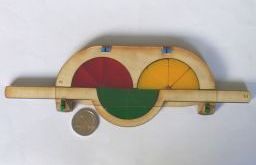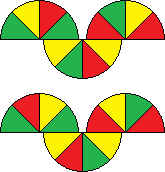



These Slide Rule Duel puzzles have pieces which in the top half of the frame form two
large circle segments, and in the bottom half only one small circle segment. The bottom
half can slide left and right so that its segment can line up with either of the top
parts to make a complete disc, which can then be rotated.

The Pie puzzles have discs cut into 8 pieces like a pizza. There are only three half-discs, so there are 12 pieces all together. The Pie 3 has three colours, four pieces of each colour, and the Pie 6 has six colours, two pieces of each colour. In the solved position the pieces of the same colour are together, forming three half discs, or 6 quarter discs.
These puzzles were invented by Douglas A. Engel, who also invented various other puzzles such as:
There are 12 pieces which can be arranged in 12! ways, but there are indistinguishable pieces so we have to divide out by the number of ways the identical pieces can be permuted, which is 4!3 for the Pie 3 and 2!6 for the Pie 6. This gives 12! / 4!3 = 34,650 positions on the Pie 3, and 12! / 2!6 = 7,484,400 positions on the Pie 6. If you consider a position different if the slider is moved across, then you have to multiply these numbers by 2.
I have used a computer to calculate God's algorithm for these puzzles. The results in the table below show that any Pie 3 position can be solved in at most 8 rotations (5.5990 on average), or 13 (9.7245 on average) if every 1/8th of a turn is counted as a separate move.
| Face turn metric | |||||||||||
|---|---|---|---|---|---|---|---|---|---|---|---|
| S i n g l e t u r n m e t r i c |
0 | 1 | 2 | 3 | 4 | 5 | 6 | 7 | 8 | Total | |
| 0: | 1 | 1 | |||||||||
| 1: | 4 | 4 | |||||||||
| 2: | 4 | 8 | 12 | ||||||||
| 3: | 4 | 16 | 16 | 36 | |||||||
| 4: | 2 | 24 | 50 | 22 | 98 | ||||||
| 5: | 24 | 100 | 104 | 24 | 252 | ||||||
| 6: | 16 | 134 | 286 | 186 | 14 | 636 | |||||
| 7: | 8 | 144 | 522 | 718 | 188 | 1,580 | |||||
| 8: | 2 | 110 | 742 | 1,788 | 889 | 44 | 3,575 | ||||
| 9: | 49 | 678 | 3,038 | 2,948 | 222 | 6,935 | |||||
| 10: | 12 | 364 | 3,190 | 5,554 | 1,066 | 2 | 10,188 | ||||
| 11: | 2 | 94 | 1,496 | 4,996 | 2,074 | 20 | 8,682 | ||||
| 12: | 4 | 186 | 1,195 | 1,170 | 14 | 2,569 | |||||
| 13: | 4 | 40 | 36 | 2 | 82 | ||||||
| Total: | 1 | 14 | 98 | 617 | 2,816 | 10,630 | 15,824 | 4,612 | 38 | 34,650 | |

There are two positions that are antipodal in both metrics, which are shown on the right. They can be reached with the move sequences R3 L2 R2 L1 R3 L-2 R-2 L1, and L3 R2 L2 R1 L3 R-2 L-2 R1. In a sense they are mirror images of each other, as you can see from the similarity between the two move sequences.
The Pie 6 can be solved in at move 11 rotations (8.6679 on average), or 19 times 1/8th of a turn (14.779 on average).
| Face turn metric | ||||||||||||||
|---|---|---|---|---|---|---|---|---|---|---|---|---|---|---|
| S i n g l e t u r n m e t r i c |
0 | 1 | 2 | 3 | 4 | 5 | 6 | 7 | 8 | 9 | 10 | 11 | Total | |
| 0: | 1 | 1 | ||||||||||||
| 1: | 4 | 4 | ||||||||||||
| 2: | 4 | 8 | 12 | |||||||||||
| 3: | 4 | 16 | 16 | 36 | ||||||||||
| 4: | 2 | 24 | 48 | 28 | 102 | |||||||||
| 5: | 24 | 96 | 128 | 40 | 288 | |||||||||
| 6: | 16 | 134 | 316 | 278 | 62 | 806 | ||||||||
| 7: | 8 | 144 | 560 | 896 | 540 | 92 | 2,240 | |||||||
| 8: | 2 | 120 | 788 | 2,000 | 2,162 | 973 | 120 | 6,165 | ||||||
| 9: | 70 | 832 | 3,376 | 6,024 | 4,796 | 1,526 | 120 | 16,744 | ||||||
| 10: | 30 | 604 | 4,375 | 12,272 | 16,203 | 9,370 | 1,686 | 24 | 44,564 | |||||
| 11: | 6 | 388 | 4,376 | 19,290 | 40,228 | 39,184 | 12,752 | 504 | 116,728 | |||||
| 12: | 1 | 130 | 3,204 | 23,512 | 77,172 | 121,128 | 66,194 | 4,464 | 295,805 | |||||
| 13: | 1,704 | 21,982 | 115,934 | 290,380 | 250,259 | 26,194 | 28 | 706,481 | ||||||
| 14: | 546 | 14,911 | 131,371 | 525,850 | 699,737 | 107,544 | 174 | 1,480,133 | ||||||
| 15: | 100 | 6,650 | 98,198 | 632,766 | 1,298,898 | 296,862 | 719 | 2,334,193 | ||||||
| 16: | 1,346 | 35,864 | 359,931 | 1,163,775 | 417,545 | 1,411 | 1,979,872 | |||||||
| 17: | 52 | 3,328 | 51,060 | 271,224 | 161,782 | 1,192 | 488,638 | |||||||
| 18: | 16 | 582 | 5,140 | 5,652 | 193 | 11,583 | ||||||||
| 19: | 2 | 3 | 5 | |||||||||||
| Total: | 1 | 14 | 98 | 665 | 3,774 | 20,895 | 108,803 | 524,175 | 2,031,897 | 3,769,787 | 1,020,574 | 3,717 | 7,484,400 | |
Hold the puzzle with the slider at the bottom. The Left and Right discs will be labelled by the letters L and R. A turn of a disc is denoted by the disc letter followed by a number that is the number of steps to turn it by, where positive numbers mean clockwise turns, and negative numbers anti-clockwise turns. So for example L2 is a clockwise quarter turn of the left disc, and R-1 is an anti-clockwise turn of the right disc by one step, one eighth of a full turn.
Phase 1: Solve the top half of the left disc.
Phase 2: Solve the second disc.
| Right disc | Solution | |
|---|---|---|
 | YYYYGGGG | Do nothing |
 | YYYGGGYG | L-2 R1 L-1 R-1 L3 |
 | YYYGGYGG | L-1 R1 L-1 R-1 L2 |
 | YYGGYYGG | L1 R-3 L-1 R-2 L1 |
 | YGYYGGYG | L2 R1 L3 R1 L2 |
 | YGYYGYGG | L-1 R-1 L-3 R-1 L-3 |
 | GYGYGYGY | L-2 R3 L1 R1 L1 R2 L-2 |
Phase 1: Solve the top half of the left disc.
The following move sequence swaps the two pieces lying in the top right quarter of the right disc:
L1 R2 L-1 R-2 L2 R1 L-2 R-1
The second disc can be solved with this sequence alone.
Phase 2: Solve the second disc.
If you want to rearrange the colours of the Pie 3, any permutation is easily achieved using half turns only. To rearrange the colours of the Pie 6 however, just using quarter turns is not enough. This is because this problem is equivalent to permuting 6 corners of the Rubik's Cube using only moves of two adjacent faces. The page about the Two-generator corners group explains the mathematics of it.
Two swap two adjacent colours of the Pie 6, rotate them to the bottom, into the slider's half disc, and
do the move sequence:
L2 R-3 L1 R3 L-3 R3 L1 R3
Then move the two colours back to where they were before.